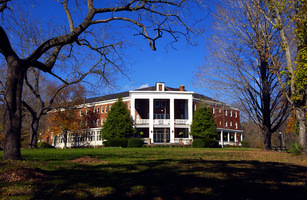 | Back to e-WV
| Back to e-WV
 The West Virginia Encyclopedia
The West Virginia Encyclopedia
 | Back to e-WV
| Back to e-WV
 The West Virginia Encyclopedia
The West Virginia Encyclopedia

Pence Springs, the name of a mineral spring and community, is located in Summers County, 12 miles east of Hinton on State Route 3. The spring’s sulfurous water is noted for a distinctive ‘‘rotten egg’’ taste arising from the concentration of hydrogen sulfide. In early times the spring was frequented by herds of wild animals, particularly buffaloes, that drank the salty water. The site also was visited by Indians, probably attracted by the abundant game. The broad fields between the spring and the Greenbrier River contain prehistoric sites, which were studied in 1984 by scholars from the University of Kentucky.
During the 19th century, the water of the spring was believed to have medicinal properties, and many visitors were attracted to the site. The property was not developed commercially as a resort until 1872 when a wooden hotel was constructed. The number of visitors rapidly increased in the late 1870s after the Chesapeake & Ohio Railway built its main line down the Greenbrier River. The railroad constructed a passenger station across the river from the resort. In 1878, the property containing the spring was sold to Andrew S. Pence, who extensively developed the site and built up a thriving business by selling water bottled at the spring. In 1904, Pence Springs water was presented the highest award in its class and a silver medal at the St. Louis Exposition. At one time, a plant to manufacture and bottle ginger ale operated at the spring.
Eventually Pence Springs became so popular that several boarding houses and hotels operated in addition to the original hotel. About 1900, E. M. Carney of Kanawha County purchased property near that of Pence and erected a rival hotel. Pence filed a lawsuit against Carney in 1904, after Carney drilled into the seam that carried water to Pence’s spring and began to sell the water in competition with Pence. The suit, which went to the West Virginia Supreme Court, was decided in favor of Carney.
In 1918, a large brick hotel was constructed by the Pence family on the hill overlooking the original spring. This hotel operated until the 1930s but closed due to lack of revenue. In 1947, the property, containing the original spring, brick hotel, and fields along the river, was purchased by the state of West Virginia for use as the state prison for women. The prison functioned until 1985, at which time the prisoners were transferred to the federal women’s prison in nearby Alderson. The hotel was placed on the National Register of Historic Places in 1985. In 1986, the property was purchased by Ashby Berkley, who renovated the hotel and reopened it for guests. He and his sister, Rosa Lee Miller, sold the property in 2001. Berkley reclaimed it in 2003, again briefly operating it as an inn. The property soon changed hands again when it became the Greenbrier Academy for Girls, a facility for troubled adolescents.
Read the National Register of Historic Places nomination for the Pence Springs Hotel Historic District.
Written by Michael M. Meador
Cohen, Stan. Historic Springs of the Virginias. Charleston: Pictorial Histories Publishing Company, 1981.
Miller, James H. History of Summers County. Hinton: J. H. Miller, 1908.
O'Malley, Nancy. Prehistory along the Greenbrier: Archaeological Investigations at Pence Springs, Summers County, West Virginia. Lexington: University Press of Kentucky, 1985.